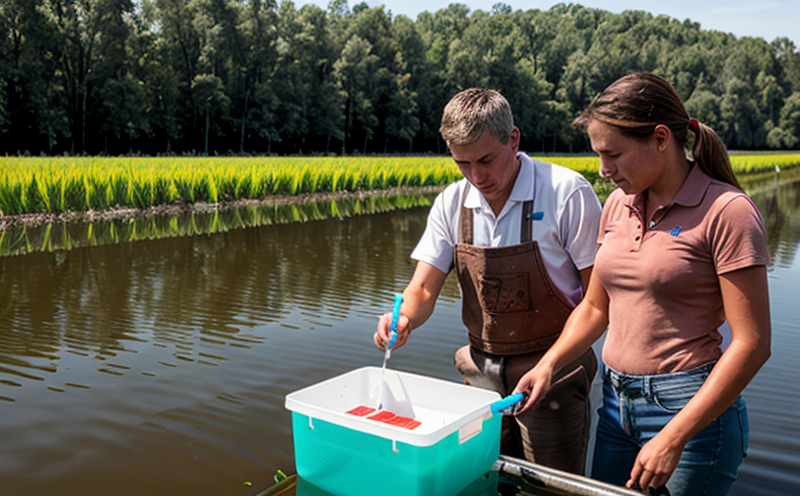Molybdenum Content Testing in Agricultural Water
Molybdenum is an essential micronutrient that plays a crucial role in plant growth and development. However, its presence in agricultural water can be detrimental if not within the optimal range. Excessive molybdenum can lead to toxicity issues affecting crop yields and quality, while insufficient levels may result in nutritional deficiencies. Therefore, accurate measurement of molybdenum content is vital for sustainable agriculture.
Water containing high concentrations of molybdenum can also pose risks beyond soil and plant health. Runoff from agricultural fields can lead to eutrophication in nearby water bodies, causing harm to aquatic ecosystems. This underscores the importance of precise monitoring and control over molybdenum levels in irrigation waters.
The testing process for molybdenum content involves several steps aimed at ensuring reliable results. Initially, appropriate sample collection is critical. Samples should be representative of the water source being tested to ensure that the analysis reflects real-world conditions accurately. Proper handling and preservation methods during transport are also essential to prevent contamination or degradation before analysis.
Once samples reach the laboratory, they undergo rigorous preparation procedures tailored specifically for molybdenum determination. This typically includes dilution steps where necessary, ensuring sample volumes align with instrument specifications. The chosen method for detecting molybdenum depends on factors like desired precision and available equipment but often employs techniques such as atomic absorption spectrophotometry (AAS) or inductively coupled plasma mass spectrometry (ICP-MS). Both methods provide high sensitivity and accuracy, making them suitable choices for this application.
After acquisition of raw data through these analytical means, statistical analysis ensures robust interpretation. This includes calibration against certified reference materials to establish accurate concentration values relative to established standards like ISO 17025 or EN 14976.
The results are reported comprehensively detailing detected molybdenum levels along with associated uncertainties derived from analytical precision. Reporting practices adhere strictly to international guidelines ensuring clarity and consistency across reports produced by different laboratories worldwide.
Understanding how variations in molybdenum content impact agricultural systems provides valuable insights into optimizing irrigation practices for improved crop performance while minimizing environmental impacts. For instance, understanding which crops are most sensitive to varying concentrations allows farmers to tailor their approaches more effectively.
Eurolab Advantages
At Eurolab, we pride ourselves on providing unparalleled expertise in agricultural water quality testing. Our team of experienced scientists and engineers brings decades of collective knowledge to each project, ensuring that our clients receive the highest standard of service.
We employ state-of-the-art instrumentation and follow strictly validated protocols based on recognized international standards such as ISO 17025 and EN 14976. This guarantees consistent and reliable results every time. Our laboratories are accredited according to relevant accreditation schemes, ensuring our tests meet rigorous quality assurance requirements.
Our commitment extends beyond mere compliance; we actively contribute towards sustainable agricultural practices by offering tailored advice on managing molybdenum levels within safe limits for both crops and the environment.
Customer satisfaction is at the heart of everything we do. From initial consultation through to final report delivery, our goal is always to exceed expectations. Our flexible approach allows us to adapt quickly to changing needs, whether that involves new analytical techniques or custom solutions designed specifically around client requirements.
International Acceptance and Recognition
The significance of molybdenum content testing in agricultural water cannot be overstated given its direct influence on crop productivity and environmental health. International standards play a crucial role in establishing uniformity across borders, facilitating trade and collaboration between countries.
ISO 17025 is one such standard that sets stringent criteria for proficiency laboratories worldwide. Compliance with this standard ensures that our tests meet high-quality assurance benchmarks recognized globally. Similarly, EN 14976 provides specific guidance on how to conduct water analysis effectively, contributing further towards achieving consistent outcomes.
Our accreditation against these international standards not only enhances credibility but also fosters trust among stakeholders involved in agricultural production and management. By adhering strictly to these guidelines, we ensure that our findings are reliable, reproducible, and accepted across various jurisdictions.
The acceptance of our results by regulatory bodies such as the Food and Agriculture Organization (FAO) of the United Nations adds another layer of endorsement. Their approval signifies that our methodologies align with best practices recommended for ensuring food safety and environmental protection.
Environmental and Sustainability Contributions
Efficient management of molybdenum content in agricultural water contributes significantly to sustainable agriculture by promoting healthy ecosystems, enhancing crop yields, reducing waste, and conserving natural resources. Here’s how:
Reduction of Nutrient Runoff: By maintaining optimal levels of molybdenum within irrigation waters, we help prevent excessive nutrient loss through runoff. This reduces the risk of eutrophication in surrounding water bodies, preserving aquatic biodiversity and supporting healthy ecosystems.
Improved Crop Yields: Proper control over molybdenum concentrations ensures that plants receive adequate amounts necessary for optimal growth without exceeding toxic thresholds. This leads to healthier crops with better resistance against diseases, pests, and adverse weather conditions.
Water Conservation: Efficient use of water resources is crucial in agriculture. By ensuring that only sufficient quantities are applied based on accurate molybdenum content measurements, we minimize wastage while maximizing efficiency.
Biodiversity Preservation: Protecting local flora and fauna from harmful effects caused by excessive molybdenum levels helps maintain biodiversity within agricultural landscapes. This promotes ecological balance and resilience against external stressors.





